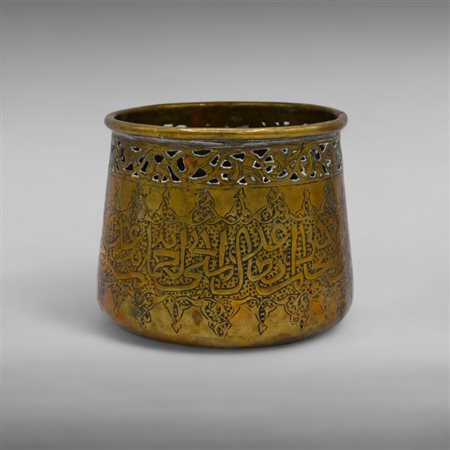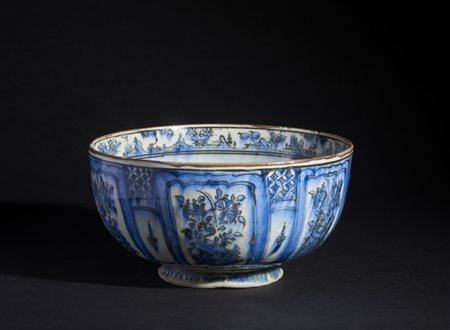Pre-Asta Islamic and Indian art from a Private Collection in Rome and other provenances. In partnership with BAIAS Arte.
-

Lotto 97 Cairoware container
Egypt, 20th century
Brass, cylindrical section and straight converging walls, the exterior decorated with a large inscription in thuluth. Engraving on the base.
H. 9 X D. 11.5 cm -

Lotto 98 A lustre painted star-shaped tile Ilkhanid
Iran, probably Kashan, 14th century
Siliceous body, decorated in reserve on brown metallic lustre with a quadripartite flower and an inscription in underglaze cobalt blue running along the edge of the tile in the form of an eight-pointed star. Originally part of a larger composition intended to decorate the walls of a building.
Provenance: Private Collection Northern Italy.
L. 20.5 cm -

Lotto 99 Bowl with mould decoration
Eastern Iranian World, 12th-13th century
Of siliceous body, the inner walls with mould decoration in relief, covered with iridescent glaze, turquoise drippings on the inner rim bordered by manganese scalloped motif.
Provenance: Private Collection Northern Italy.
H. 9 X D. 16 -

Lotto 100 A Bamyan cup with engraved decoration
Central Asia, 12th-13th century
Small slip painted terracotta bowl, the interior walls with incised decoration arranged within cartouches containing manganese-coloured roundels alternating with panels with a fish scale-like motif with green roundels.
Provenance: Private Collection Northern Italy.
13.5 X H. 6.7 cm -

Lotto 101 A Kashan pottery model Seljuk
Iran, 12th-13th century
Lantern or model with four mihrab niches, one on each side, in moulded fritware and covered with turquoise glaze. Rectangular in shape, resting on four feet, the edges emphasised by a ¿torchon¿ element and a roof with a central hole. Among Kashan's production from this period are artefacts commonly referred to as 'model houses', a peculiar serial production, similar to the object presented here, depicting houses without roofs that allow us to appreciate the subdivision of spaces and sometimes even tables set with caterers.
15.5 X 11 X 10 cm -

Lotto 102 A Kashan moulded lustre tile Ilkhanid
Iran, 13th century
Rectangular, in moulded siliceous paste with floral decoration and central mihrab niche in relief. Half palmette frieze in the upper edge. Painted with white slip, finished with turquoise underglaze and third-firing brown metallic lustre. Restorations.
Provenance: Private Collection Northern Italy.
H. 21.5 X l. 23 cm -

Lotto 103 A Chinese inspired blue and white Safavid huqqa base (Kendi)
Iran, 17th century
fritware body with typical globular shape, hourglass shaped neck and a bulging, faceted pourer in this case instead of the usual rounded form. The surface with underglaze blue decoration imitating the Chinese tradition featuring tall pagodas in a maritime context, a stylised wave motif encircles the base and floral motifs adorning the shoulder and neck. Characteristic of Safavid production is the black outline and the pseudo Chinese-inspired mark on the base. Flaws and cracks.
H. 16,2 X L. 13 -

Lotto 104 A large Safavid blue and white pottery bowl
Iran, 17th century
Resting on a slightly flared circular foot and shoulder terminating in a straight edge. The exterior with decoration outlined in black and coloured with cobalt blue underneath, painted with vertical lobed panels containing birds among flowers interspersed with smaller panels with abstract decoration. The upper inner border featuring a band containing birds in flight over a lake landscape and a central roundel with two fawns among plants.Objects of this type had spread to Persia as an emulation of Chinese porcelain, which had penetrated into Iran with the pax mongolica and over the centuries Persianised with black outline and local subjects.
28 X H. 14.5 cm -

Lotto 105 A blue and white Multan pottery tile Nowadays
Pakistan, 19th century
Part of a larger decoration in moulded ceramic with central decoration in the form of a palmette in relief, outlined by the blue border framing two floral reserves on a turquoise background. Inside the cartouches are two religious inscriptions (Ya Allah, Ya Muhammad) in reserve on cobalt blue. Floral elements on a white background complete the composition. For comparison see David Collection in Copenhagen, Acc. no. 29/1989.
Provenance: Private Collection Northern Italy.
33 X 28 X H. 3 cm -

Lotto 106 Damascus tile with floral racemes
Ottoman Empire, late 16th - early 17th century
Border tile, made of siliceous paste, the front painted with interlaced flowers and leaves, fitted with a band of split palmettes on one side. Provenance: Private Collection Northern Italy.
H. 29 X L. 28.5 cm -

Lotto 107 Multan tile panel Nowadays
Pakistan, 19th century
Composed of 8 tiles mounted on a wooden board, each depicting three connected hamsa, two of white color and one cobalt blue. The vertical conjunctions with the other tiles are turquoise rhombuses. Potentially infinite patterns such as this allude to one of God's main characteristics of being with no end and no beginning.
Provenance: Private Collection Northern Italy.
H. 23 X L. 50 cm -

Lotto 108 A bronze ewer
India, Deccan, early 18th century
Resting on a hexagonal base, the body is globular and slightly flattened, the handle in the form of a stylised dragon terminating in a hinge that joins it to the domed cover terminating in a bud-shaped grip. The surface is extensively decorated with a fish scale pattern and a net motif of small diamonds on spout and neck. The centre of both sides of the container decorated with a peacock within a drop-shaped reserve.
Ewers of this shape are attributed by Zebrowski (Gold, Silver & Bronze from Mughal India, Alexandria Press, 1997, p. 164 and 166) to Northern India or the Deccan. Our specimen seems to relate more to the second attribution, given its decorative similarities to the coeval Bidri manufacture.
Such items were used by the Muslim community to pour water for ritual ablutions and is therefore a type frequently found in India after the Islamic conquest of some of its territories.
31.5 X H. 29 cm -

Lotto 109 A zoomorphic bronze candle stand
South India, 19th century
Bronze casting with brown patina and central stem depicting a rampant lion resting its two front paws on the head of an elephant.
25 X H. 34.5 cm -

Lotto 110 A bronze casket
India, 19th century
Of rectangular shape, standing on four feet, the prism-shaped lid hinged at the back. The exterior engraved with birds with worms in their beaks and geometric rosettes within profiles containing plant motifs.
20.5 X H. 22.5 X P. 15 cm -

Lotto 111 Sealed earthenware flask
Northern India, Nizanabad, 19th century
In the form of a moonflask, carved earthenware with a central flower and plant racemes.
H. 23 X D. 12.5 cm -

Lotto 112 Group of three clay praying plaques (turbah)
Middle East, 19th - 20th century
Lot consisting of three dry clay plaques decorated with sacred monuments of the Islamic religion (the Dome of the Rock and the Mosque of Medina) and the last one with Arabic inscriptions. Tablets of this type are mainly used in Shiite circles as an aid for prayer as one of the prescriptions requires prostration to take place on the ground or on a natural element in the absence of soil. These tablets are therefore used as substitutes for soil.
H. 7,5 cm (the largest) -

Lotto 113 Two tin-plated copper containers
Turkey or Levant, 17th century
One with a small central umbo, engraved with fishes around the centre with small stylised arrows arranged in a radial pattern. The smaller one (15 cm diameter) decorated with godrooned motif on the outside, engraved interior with central inscription and abstract motifs.
D. 24 X H. 4.5 cm -

Lotto 114 A silver and copper inlaid Cairoware brass bottle
Egypt 20th century
H 27.5 cm -

Lotto 115 Cairoware brass lamp piece
Egypt, late 19th - early 20th century
brass sheet in the form of a flared apex with suspension chains, the exterior engraved with plant racemes within arabesques inlaid with silver thread.
H. 11.7 X 7.5 cm -

Lotto 116 Prayer Book (Dor.d-e Mosta..t)
Persia, 17th - 18th century
Arabic manuscript on paper, composed of 58 papers, complete. Folio 132 x 80 mm, writing box 98 x 50 mm. Text in Naskh script on a single column of 17 lines in black ink, with important words in red ink.The decoration includes four frontispieces (unwan) illuminated in gold and colours and numerous chapter titles in white or gold ink. Persian margin notes in nasta'liq calligraphy . Leather binding with flap decorated in red and gold.Traces of use and reinforcement on some papers, restored tear in last paper.
13.5 X 8.5 cm -

Lotto 117 Pilgrim's Guide (Dalai al-Khayrat)
Possibly Syria, copied from Imam of the Berber 'a.iliya, dated 1133 AH (1721 AD)
Arabic manuscript on laid paper composed of 49 folios (of which a couple are seriously damaged), complete.Folio meas: c. 145 x 100 mm; writing box c. 120 x 65 mm. Text in Naskh calligraphy penned in black ink and important words and titles in red, arranged in a single column. The decoration includes a depiction of the pulpit of the Medina mosque, albeit very faded. Cardboard binding.
14.5 X 11 cm -

Lotto 118 A Chinese 30th Juz of Qur'an
China, 18th century
Arabic text on paper, composed of 53 papers. Text in broad sini calligraphy in black ink with red diacritics and Sura headings. Folio: 275 X 200 mm; writing box 182 X 124 mm bordered by double red lines. Five lines to the page, arranged in a single column. Double frontispiece (sarlaw) with multicoloured geometric and floral decoration on a gilt background.
27,5 X 20 cm -

Lotto 119 Manuscript Fatwa of Coffee
Ottoman Turkey, 18th century
Manuscript on polished, laid and watermarked paper, in the Osmanili (Ottoman Turkish) language. Composed of 147 folios, 146 of text only. Sheet: c. 204 x 133 mm; writing rule: c. 136 x 73 mm; 17 lines to the page in black and red ink. Frontispiece missing, but the first two pages bear writing box outlined by gilt fillet. The text consists of a miscellany of legal judgments issued by famous Ottoman jurists, including those by the celebrated jurist of the Hanafite school 'eAb. as-Su..d, known in Turkish as Ebusuud.
20.4 X 13.8 cm -

Lotto 120 Frontispiece (Unwan) of Shahnameh
Persia or Kashmir, 17th-18th century
Persian text on paper. Script box c. 140 x 135 mm surmounted by multicoloured floral illumination on a gold background with blue poly-lobed reserves. Text in nasta'liq script arranged in four columns and penned in black ink with titles in red. Reclamantes in Persian in the lower margin. Restoration.
280 x 180 mm ca.
